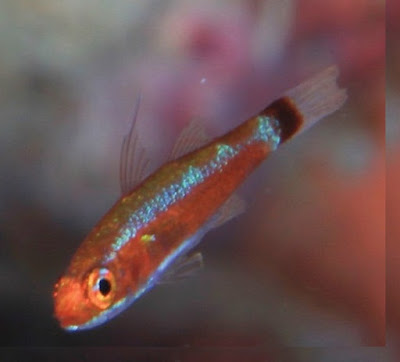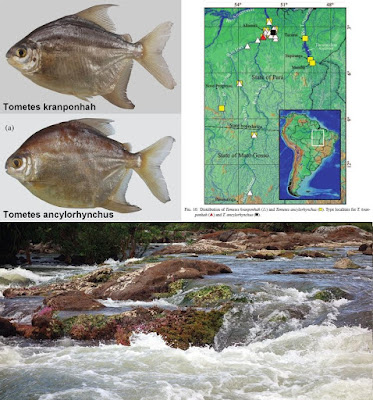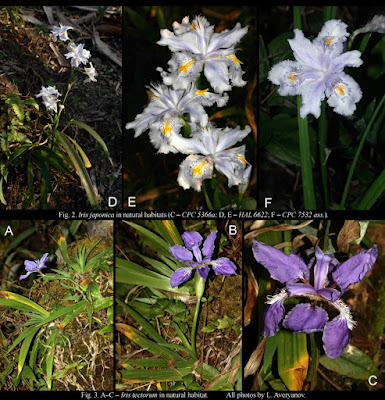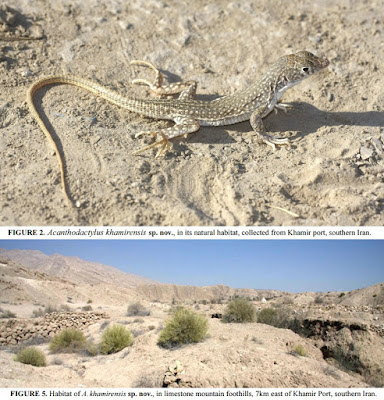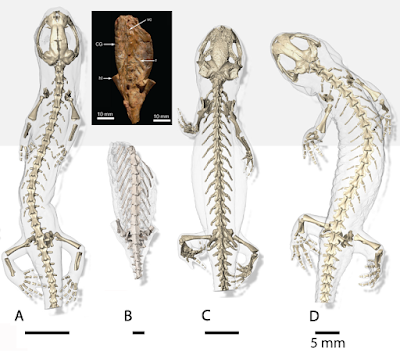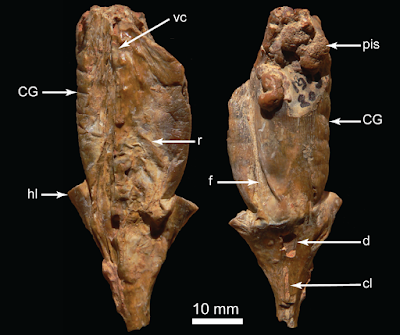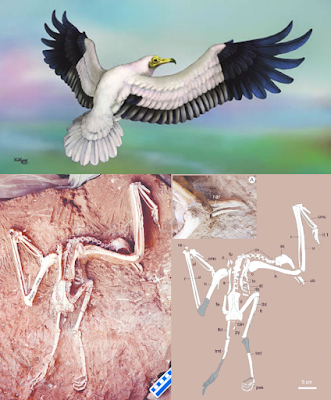[Most Recent Entries] [Calendar View]
Tuesday, July 26th, 2016
| Time | Event | ||||
| 10:07a | [Ichthyology • 2016] Trimma tevegae and T. caudomaculatum revisited and redescribed (Acanthopterygii, Gobiidae), with Descriptions of Three New similar Species from the western Pacific; Trimma burridgeae, T. hollemani & T. corerefum
Abstract A redescription and diagnosis of Trimma tevegae, based on 50 additional specimens from the type locality at Rabaul, New Britain is provided, and contrasted with the redescription and diagnosis of T. caudomaculatum, based on the type material and an additional 22 specimens from various western Pacific localities. Trimma tevegae may most easily be recognized by the lack of a blue stripe (dark in preservative) in the dorsal midline of the snout, and a short second spine in the first dorsal fin, reaching posteriorly to the origin or first few ray bases of the second dorsal fin. Trimma caudomaculatum can be identified by the blue stripe from the snout along the dorsal midline, the blue spots and stripes in front of the eye, on the opercle and beneath the eye (dark in preserved material), and the very elongate second dorsal spine, usually extending to beyond the end of the second dorsal fin. Three similar-looking new species are described. Trimma burridgeae and T. hollemani are morphologically very close to each other, differing mainly in the length of the second dorsal spine (to the posterior base of the second dorsal fin or beyond in T. burridgeae; to the anterior base of that fin in T. hollemani). These two species differ by over 9% of the bases of the COI gene. Trimma corerefum is the most distinctive of the species, differing in lacking a blue stripe on the dorsal surface of the snout, in the pigment pattern around the eye, in having fewer cephalic sensory papillae (free neuromasts) in rows dʹ, ea, ep, f, r and ot, and in a shorter fifth pelvic fin ray (34–45% length of fourth pelvic ray). The morphological differences between the species are reinforced by the results of a barcode analysis of the COI gene, based on 105 specimens. Keywords: Pisces, taxonomy, Western Pacific, coral reef gobies, COI gene Richard Winterbottom. 2016. Trimma tevegae and T. caudomaculatum revisited and redescribed (Acanthopterygii, Gobiidae), with Descriptions of Three New similar Species from the western Pacific. Zootaxa. 4144(1); DOI: 10.11646/zootaxa.4144.1.1 | ||||
| 2:17p | [Ichthyology • 2016] Tometes kranponhah & T. ancylorhynchus • Two New Phytophagous Serrasalmids (Characiformes: Serrasalmidae), and the First Tometes species described from the Brazilian Shield
Abstract Two new species of Tometes from the Brazilian Shield rapids are described. Tometes kranponhah is endemic to the Xingu River basin, whereas Tometes ancylorhynchus occurs both in the Xingu and the Tocantins–Araguaia River basins. The two species are sympatric in the Xingu drainages and have many similarities in morphology and colouration. Major diagnostic differences are the dark pigmentation on the opercle of T. kranponhah and its distinct snout shape and arrangement of premaxillary teeth. In addition, T. kranponhah is a large fish that is abundant in the Xingu River, whereas T. ancylorhynchus is a medium-sized fish for which there are few records. M. C. Andrade, M. Jégu and T. Giarrizzo. 2016. Tometes kranponhah and Tometes ancylorhynchus (Characiformes: Serrasalmidae), Two New Phytophagous Serrasalmids, and the First Tometes species described from the Brazilian Shield. Journal of Fish Biology. 89; 467–494. DOI: 10.1111/jfb.12868 | ||||
| 2:21p | [Botany • 2016] The Iris Family (Iridaceae) in the Flora of Eastern Indochina
Summary Iris family in the countries of eastern part of Indochina Peninsula, such as Cambodia, Laos and Vietnam includes lone native genus – Iris L. with two aboriginal species – I. japonica Thunb. and I. tectorum Maxim. Iris japonica is often cultivated as an outdoor ornamental plant in mountainous regions in the northern Vietnam, where it occasionally naturalizes. Herbarium specimens of I. japonica, collected in central Laos near Nape town, probably represent southernmost locality of the Iris genus in Eurasia. Iris tectorum was discovered in native, primary plant communities of karstic highly eroded limestone in Cao Bang province (Bao Lac district) of the northern Vietnam. This species is recorded as new for the flora of the Indochina Peninsula. The report of I. collettii Hook. f. on the territory of peninsular flora does not yet confirmed by herbaria and remains doubtful. Data on taxonomy, authentic specimens, distribution, habitats, phenology, conservation status and biology are provided for all Iris species. The identification key for Iris species is compiled, as well as dotted distribution maps on the territory of countries of eastern Indochina. Other representatives of the family from such genera as Belamcanda Adans. (B. chinensis (L.) Redouté), Crocosmia Planch. (C. × crocosmiiflora (G. Nicholson) N. E. Br.), Eleutherine Herb. (E. bulbosa (Mill.) Urb.), Freesia Klatt (F. refracta (Jacq.) Klatt.), Gladiolus L. (numerous horticultural forms) и Trimezia Salisb. ex Herb. (T. martinicensis (Jacq.) Herb.) reported from Indochina are introduced cultivated ornamental plants capable to occasional naturalization as an adventive element of the Indochinese flora. Key words: Iridaceae, Iris, eastern Indochina, Laos, Vietnam, plant diversity, taxonomy. L. V. Averyanov, E. V. Boltenkov, T. V. Maisak, Khang Sinh Nguyen and Hiep Tien Nguyen. 2016. The Iris Family (Iridaceae) in the Flora of Eastern Indochina. Turczaninowia. 19(1); 27–33. DOI: 10.14258/turczaninowia.19.1.3 | ||||
| 3:06p | [Herpetology • 2013] Acanthodactylus khamirensis • A New Species of Acanthodactylus Fitzinger 1834 (Sauria: Lacertidae) from southern Iran
Abstract A new and distinctive species of lacertid genus Acanthodactylus Fitzinger, 1834 is described from 7 km east of Khamir Port, Hormozgan Province, southern Iran at an elevation of 30–40m above sea level (asl). Analyses of morphological characters and the comparison with other formerly known species of this genus have proven the status of this taxon as a new, distinct species. Combinations of scalation characters and distinct morphology, coloration and habitat peculiarities in calcareous mountains distinguish Acanthodactylus khamirensis sp. nov. from all remaining species of the genus in the area. In order to show the validity of the new species, we carried out a comparative statistical analysis using 13 metric and six meristic morphological characters on all of the neighboring congeners of the new species using descriptive (one-way ANOVA) as well as multivariate analyses (PCA and DFA). The results confirm the specific status of the new taxon. Detailed information and an updated identification key for the genus Acanthodactylus in Iran are presented. Keywords: Lacertidae, Acanthodactylus, A. khamirensis, Morphology, PCA, DFA, Hormozgan, Iran Diagnosis. The new species differs from all other Acanthodactylus species in having a combination of the following characters: a relatively medium sized lacertid (Fig. 2), with SVL: 48.43mm, TL: 91.89mm. Dorsal scales nearly smooth and imbricate; three supraoculars, the first one smaller than two entire middle ones (Fig. 3 A–B). Subocular bordering the mouth not separated from the lip border (Fig. 3–C). Dorsal scales the same size as laterals; ventral scales relatively imbricate, in 11 longitudinal rows and 34 ventral series in a longitudinal row along the belly between collar and preanal scale; dorsal scales 64 across middle of back; four supralabials anterior to subocular and three posterior to subocular; six infralabials; three series of scales around fingers, but two visible laterally; 22 rows of lamella under the 4th toe; 15 rows of lamella under the 4th finger; 24 femoral pores on each side, extended laterally to reach the knees; the two rows are separated by a space as large as diameter of each pore. Habitat. The Khamir port is among the driest areas in southern Iran, with relatively high humidity (75%) and annual rainfall averaging about 120 mm, air temperature varies from 1°C during winter to 50°C during summer. Acanthodactylus khamirensis sp. nov. is found on calcareous mountains at the foothills of mountains around deep valleys, which undergo strong erosion. The habitat is without any vegetation except isolated shrubs with fleshy and needle-like leaves belonging to the family Zygophyllaceae (Peganum sp.) as the only vegetation cover in the area. The lizard can easily take refuge inside these dense bushes. Acanthodactylus khamirensis sp. nov. is approximately distributed in a mountainous habitat on bases with hardened substrate (Fig. 5). The specimens of A. khamirensis were collected during daytime, while running on the ground in relatively cool and fresh air during early morning and late sunset. In spite of frequent visits to the area, no other reptile species was collected or observed as sympatric and/or syntopic with A. khamirensis. Etymology. The species is named after the place and locality where the species has been collected (Khamir Port, Hormozgan Province, Southern Iran) and the Latin ‘-ensis,’ meaning ‘from’ or ‘belonging to’. Heidari, Naghi, Nasrullah Rastegar-Pouyani, Eskandar Rastegar-Pouyani & Mehdi Rajabizadeh. 2013. A New Species of Acanthodactylus Fitzinger 1834 (Sauria: Lacertidae) from southern Iran. Zootaxa. 3722(3); 333-346. DOI: 10.11646/zootaxa.3722.3.3 | ||||
| 3:50p | [Paleontology • 2016] Phosphotriton sigei • Synchrotron Analysis of A ‘Mummified’ Salamander (Vertebrata: Caudata) from the Eocene of Quercy, France
Abstract An incomplete ‘mummy’ from the Phosphorites du Quercy (presumed Eocene) was identified as a salamander during the 19th century. The specimen has now been computed tomography (CT) scanned, and this revealed the incomplete skeleton (with perfectly preserved bones) and soft tissues (lung). The fossil represents a new, well-characterized taxon. Despite the absence of the skull, several features allow a phylogenetic analysis. The fossil belongs to pseudosaurian caudates; it is tentatively assigned to the Salamandridae, although affinities with Plethodontidae cannot be definitely ruled out. Keywords: exceptional preservation; Lissamphibia; Phosphorites du Quercy; phylogeny; Salamandridae; skeleton; tomography; Urodela Systematic Paleontology Caudata Fischer von Waldheim, 1813 Pseudosauria Blainville, 1816 ?Treptobranchia Frost, Grant, Faivovich et al., 2006 ?Salamandridae Goldfuss, 1820 Phosphotriton gen. nov. Etymology: Greek ϕωσϕόρος, phosphorus, in reference to the nature of the sediment; triton, a frequent suffix in the genus names of salamanders. Phosphotriton sigei sp. nov. Holotype: An incomplete ‘mummified’ body of a salamander (MNHN.F.QU17755). Diagnosis: A non-elongate, lunged caudate amphibian referred to Pseudosauria, based on the presence of a median process on the ischium, clearly separated para- and diapophyses on trunk vertebrae, spinal nerves exiting intravertebrally in caudal vertebrae, and in lacking articulated ribs in the caudal region. Tentatively referred to Salamandridae on the basis of having a paired sacral rib, a median notch in the posterior border of the neural arch, neural spines low on trunk vertebrae, neural spines present on caudal vertebrae, a bony lamina connecting para- and diapophyses, and spinal nerves exiting intravertebrally in posterior trunk vertebrae. Differs from other Pseudosauria by the presence of an anterior interzygapophyseal ridge, a dorsal alar process extending between the parapophysis and prezygapophysis and amphicoely of centrum, an association of characters that is unique within the clade.
Type locality: Unknown locality of the Phosphorites du Quercy, south-western France. Horizon: Likely Eocene (late Middle or Late Eocene). Etymology: After Bernard Sigé, one of the main contributors of the Quercy campaigns. ...... Jérémy Tissier, Jean-Claude Rage, Renaud Boistel, Vincent Fernandez, Nicolas Pollet, Géraldine Garcia andMichel Laurin. 2015. Synchrotron Analysis of A ‘Mummified’ Salamander (Vertebrata: Caudata) from the Eocene of Quercy, France. Zoological Journal of the Linnean Society. 177(1); 147–164. DOI: 10.1111/zoj.12341 | ||||
| 4:00p | [PaleoOrnithology • 2016] Mioneophron longirostris • A New Old World Vulture from the late Miocene of China sheds light on Neogene shifts in the past Diversity and Distribution of the Gypaetinae
ABSTRACT Neogene fossils of Old World vultures (Aegypiinae and Gypaetinae) are known from both Old World and New World records. There are no extant Old World vultures in the Americas today, although a large diversity of Gypaetinae is known from Miocene to late Pleistocene records. Despite a comparatively large number of North American gypaetine fossils, complete specimens have rarely been reported from Eurasia and Africa. We describe the exceptional skeleton of a new gypaetine vulture from the late Miocene deposits of the Linxia Basin in northwestern China. The specimen is the oldest record of Gypaetinae from Eurasia or Africa. A reexamination of the geographic and temporal distribution of most Old World vultures from Neogene deposits indicates a diverse radiation, coincident with early- to mid-Miocene grassland expansion for Gypaetinae. Although the diversification of Aegypiinae has been linked to the transition from C3 to C4 grassland, Gypaetinae diversification predates that transition in both North America and Asia. A shift in the known latitudinal distribution is also noted. Neogene records of Old World vultures are found primarily in mid- and high-latitude regions of North America and Eurasia as well as in the middle and low latitudes of Eurasia and Africa. With very few records in the middle to late Miocene, a latitudinal distribution similar to that of extant species is first seen in the early Pliocene. The new fossil provides further temporal constraints on avian subclade diversification. It is also consistent with an emerging pattern of profound recent shifts in avian diversity and distribution more generally. Keywords: extinction, fossil, Gypaetinae, Linxia, Old World vulture SYSTEMATIC PALEONTOLOGY AVES Linnaeus, 1758 ACCIPITRIDAE Vieillot, 1816 Gypaetinae Vieillot, 1816 Holotype: HMV 1877: A nearly complete skeleton (Figure 1) preserved in yellow-brownish siltstone with carbonate cementation. The proximal right tarsometatarsus and distal left tarsometatarsus have been rearranged after collection (illustrated as dark gray regions in Figure 1). Some bones have been fabricated and others recomposed in a wrong position (e.g., pedal digits). The left distal humerus is reconstructed with plaster and the proximal right tarsometatarsus appears to be a proximal tibiotarsal fragment, without any definite clue to its affinity. The position of the hallux opposite of where it should be in the right pes is one indication that the pedal digits were recomposed. Locality and horizon: The holotype was collected from Baihua Village, Zhuangheji Town, Guanghe County, in Gansu Province, northwestern China (Figure 5: star), in the Upper Miocene Liushu Formation, Linxia Basin. All currently known fossil birds in the Linxia Basin are from the same unit, which is characterized by a distinct matrix lithology (Deng et al. 2013). The bird fossils have been acquired from local farmers and collectors. The holotype specimen is archived in the Hezheng Paleozoological Museum, Gansu Province, China. Etymology: The genus name, “Mioneophron,” references the Miocene age and the proposed affinity of the new specimen with Neophron. The adjectival species name, longirostris, references an elongate rostrum. Diagnosis: Mioneophron longirostris can be differentiated from all other gypaetine and aegypiine vultures by the unique presence of a combination of the following features: a long and narrow rostrum with small oval-shaped nares (Figure 1), a well-projected and globose humeral head and distinct caudal ridge on the margin of the deltopectoral crest, a much longer ulna than tibiotarsus (ratio = 1.45), and a distinct groove between the dorsal iliac ridges (Figure 2). Systematic placement of the new species The new species shares several features with gypaetine vultures, including the relatively weakly projected transverse nuchal crest on the basicranium as well as the broad humeral deltopectoral crest. It also has fewer cervical vertebrae (14, vs. 15–17 in Aegypiinae; Rich 1980, Holdaway 1994), and the postacetabular ilia are incompletely fused to the sacrum (Figure 4; Jollie 1976, 1977a, 1977b, 1977c), both of which are features consistent with gypaetine vultures. However, Mioneophron has a wider deltopectoral crest than aegypiine vultures, a deeper humeral capital incisure, a gentler bicipital crest, and a shorter mandibular symphysis. Furthermore, unlike in aegypiine vultures, no pneumatic foramina are present on the proximal surface of the pisiform process of the carpometacarpus (Manegold et al. 2014). The medial hypotarsal crest is slightly higher than that of the lateral one in the cranial view, whereas in Aegypius, Trigonoceps, and Torgos the 2 hypotarsal crests are very similar in height. Zhiheng Li, Julia A. Clarke, Zhonghe Zhou and Tao Deng. 2016. A New Old World Vulture from the late Miocene of China sheds light on Neogene shifts in the past diversity and distribution of the Gypaetinae. The Auk. 133(4); 615-625. DOI: 10.1642/AUK-15-240.1 RESUMEN: Los fósiles del Neógeno de buitres del Viejo Mundo (Aegypiinae y Gypaetinae) se conocen de localidades en el Viejo y el Nuevo Mundo. Actualmente no existen buitres del Viejo Mundo en las Américas, aunque se conoce una gran diversidad de Gypaetinae a partir de registros del Mioceno al Pleistoceno tardío. A pesar de un número comparativamente grande de fósiles de Gypaetinae en Norte América, los reportes de especímenes completos en Eurasia y África son raros. En este trabajo describimos el esqueleto excepcional de un nuevo buitre gypaetino de los depósitos del Mioceno tardío de la cuenca Linxia en el noreste de China. El espécimen es el registro más viejo de Gypaetinae de Eurasia o África. La reevaluación de la distribución geográfica y temporal de la mayoría de los buitres del Viejo Mundo en depósitos del Neógeno indica una radiación diversa que coincide con la expansión de las praderas durante el Mioceno temprano a medio. Aunque la diversificación de Aegypiinae ha sido relacionada con la transición de praderas C3 a praderas C4, la diversificación de Gypaetinae precede esa transición en Norte América y Asia. También notamos un cambio en la distribución latitudinal. Los registros del Neógeno de buitres del Viejo Mundo se encuentran principalmente en regiones de latitud media y alta en Norte América y Eurasia, y también en regiones de latitud media y baja en Eurasia y África. Con tan pocos registros en el Mioceno medio a tardío, una distribución latitudinal similar a la de las especies actuales sólo se ve inicialmente en el Plioceno temprano. El nuevo fósil impone más restricciones temporales en la diversificación de subclados de aves. También es consistente con un patrón emergente de cambios profundos recientes en la diversidad y distribución de las aves en general. Palabras clave: buitres del Viejo Mundo, extinción, fósil, Gypaetinae, Linxia |
| << Previous Day |
2016/07/26 [Calendar] |
Next Day >> |
